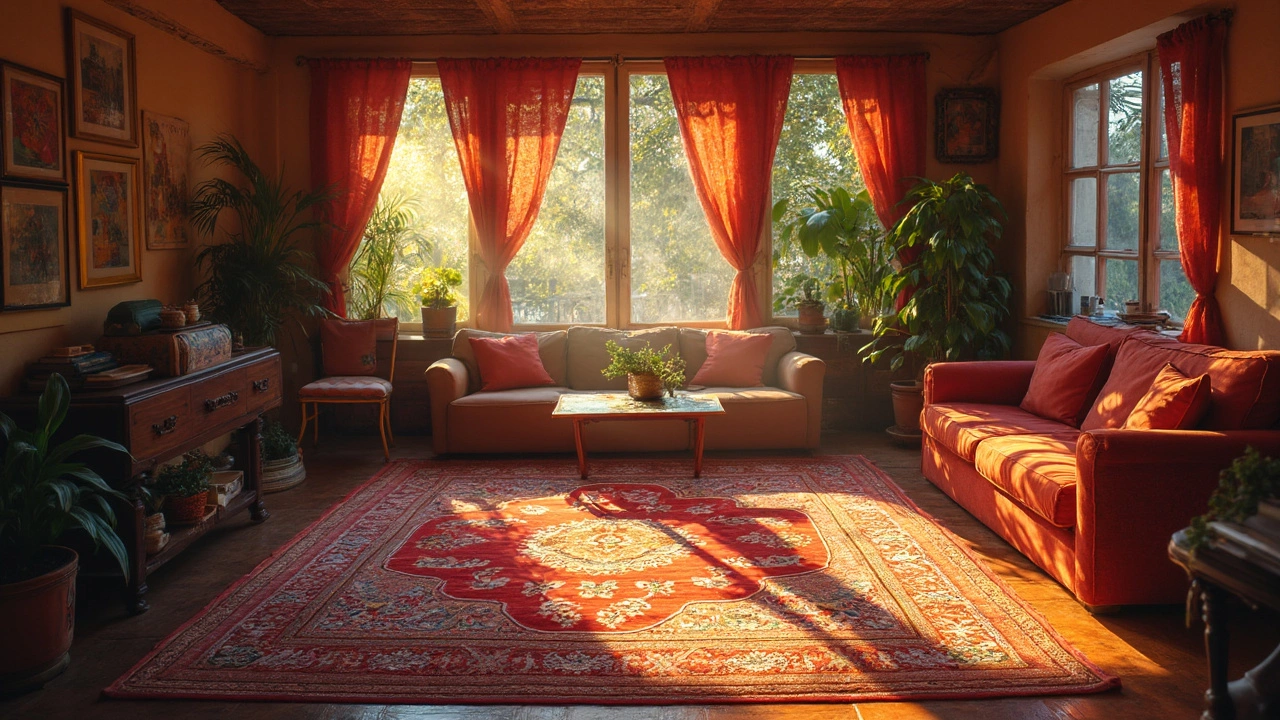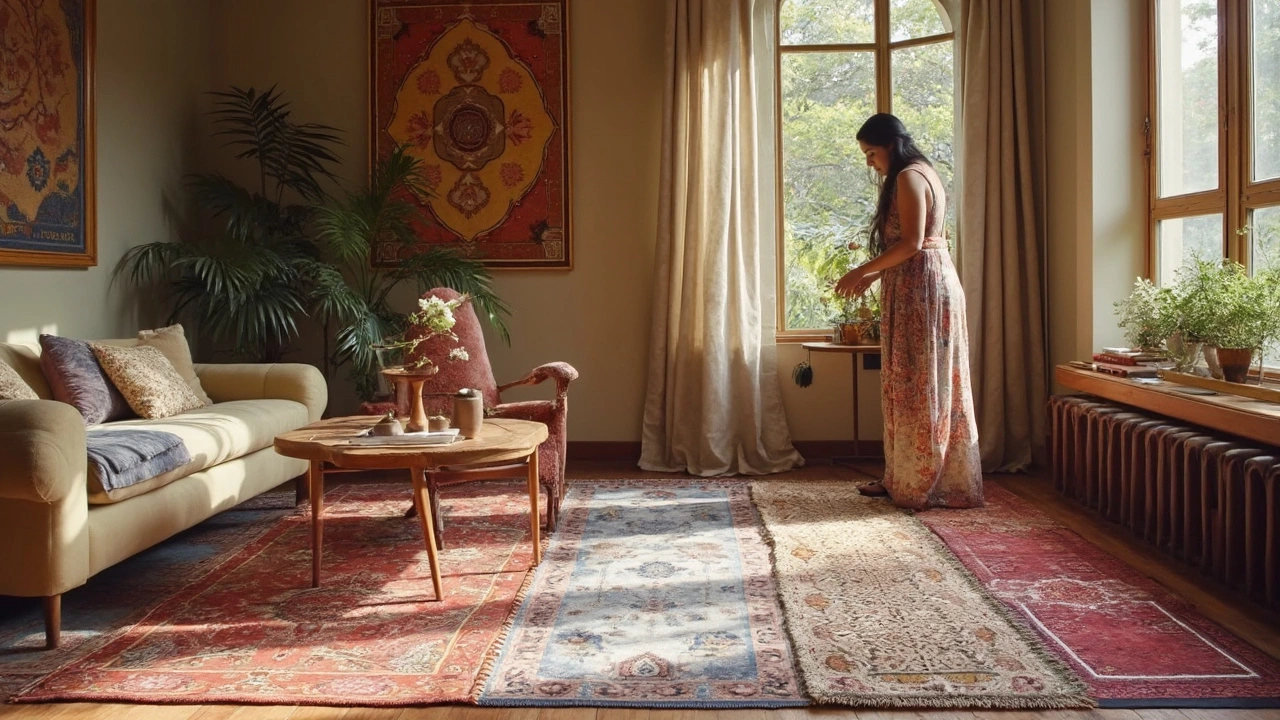Unraveling the Rug Rule: What You Need to Know

Alright, let's talk rugs. Imagine you're sipping coffee, looking at your living room, and something feels off. That rug in the middle maybe? That's where the rug rule swoops in to save the day. It’s all about making your space feel just right without diving into a full-blown redesign.
First up, consider the rule of size. Sounds basic, but getting the dimensions right can make or break a room. Too small, and it looks like a postage stamp on a canvas. Too big, and your room feels cramped. It's about balance, hitting that sweet spot where everything ties together beautifully.
- The Basics of the Rug Rule
- Why Size Matters
- Choosing the Right Patterns
- Room-Specific Strategies
- Common Mistakes to Avoid
- Expert Tips for Perfect Placement
The Basics of the Rug Rule
So, what is the rug rule anyway? It's not just a gimmick. Simply put, it's a guideline to help you choose the best rug for your area, ensuring it fits both practically and aesthetically. At its heart, the rug rule focuses on the three critical aspects: size, placement, and design. Get these right, and you've got a recipe for a cozy, stylish room.
Let’s break it down. Ever heard of the 'All Legs On, All Legs Off' principle? It’s a neat trick for those dealing with furniture. If your furniture is entirely on the rug, it creates a unified space. If all legs are off, you're defining an area visually without mixing zones. It's like magic for any setting, from the living room to the bedroom.
Of course, we've got our size matters rule. While people often measure based on the living room, it works elsewhere too. Dining rooms are the perfect example. Your rug needs to be big enough that when you push back your chair, you're still on the rug—no awkward half-on, half-off situation!
Owning a rug is about more than just floor coverage; it's about making a statement. Here’s a quick rundown of some no-fail sizing statistics:
- For a medium-sized living room, a 5x8 rug usually does the trick.
- Larger spaces or open-plan rooms often benefit from an 8x10 or even a 9x12 rug.
- In the dining area, aim for your rug to extend at least 24 inches beyond the table all around.
And let's not forget the rug's main job—comfort! Instantly make a room homier with the right plushness underfoot. A well-placed rug softens up hard flooring and can add warmth literally and visually.
Sure, this rule isn't set in stone. It’s meant to guide and inspire, not restrict. Your home is your canvas, after all. Remember, these guidelines are there to help you get the most out of your space—ensuring that every rug feels purposeful and every room feels complete.
Why Size Matters
Alright, so why do we stress so much about picking the right size when it comes to **rugs**? It's like finding the perfect pair of shoes—comfort and fit are everything. A rug that's too small can make your space look choppy, while one that's too big can overwhelm the room. You want it just right to pull your decor together.
Think about a living room. The golden rule here is keeping all your furniture legs on the rug, or at least the front ones. This not only anchors the room but also creates a cozy, inviting space where you can picture yourself chilling with Rufus.
"A correctly sized **rug** can completely transform a space," says Joanna Gaines, a respected figure in interior design. "It's all about achieving harmony in a room."
Here's a quick guide for different spaces:
- Living Room: Measure the seating area and opt for a rug size that allows at least the front legs of your sofas and chairs to rest on it.
- Dining Room: The rule of thumb is that the rug should extend at least 24 inches beyond all sides of the dining table. This helps when pulling out chairs without catching the edges.
- Bedroom: Ideally, your bed sits centered on the rug, with enough rug area on each side for you to step onto when you get out of bed.
Interestingly, data from rug retailers indicate that the most missed step is measuring the area before shopping, resulting in a high number of returns. So, grab that measuring tape before heading online or to the store.
Size is one of those details that’s easy to overlook, but incredible when done right. Keep it easy, and focus on how your space feels after you’ve laid that perfect rug down. It’s like magic for your floors!
Choosing the Right Patterns
Patterns in rugs can either pull a room together or turn it into a visual mess. What you want is a harmonious vibe that's pleasing to the eye, not something that makes you dizzy after a busy day. Here's the deal: patterns should complement your existing style, not compete with it.
First, consider the size of the space. In larger rooms, bold and larger patterns can add depth without overwhelming things. Conversely, in smaller areas, smaller or subtle patterns work wonders, as they don't overcrowd the visual field.
Before you grab that bright psychedelic design, think about the room’s purpose. For instance, a living room might benefit from intricate oriental motifs for elegance, while a kid's room might come alive with playful geometric shapes. Your rug should vibe with the room's function and mood.
Neutral base with a pop of pattern works like magic too. If your room is already bustling with bold decor, then a rug with a neutral color and a modest pattern can work wonders to balance everything out.
Here's a quick cheat sheet:
- Monochromatic rooms: Go for bold textures and designs.
- Eclectic settings: Soft patterns can tie diverse elements together seamlessly.
- Traditional spaces: Classic patterns like florals or medallions bring a timeless touch.
Last but not least, consider the upkeep. Some patterns, like intricate geometrics, might hide dirt and spills pretty well, which is great if you have kids or pets. Trust me, if you've got a dog like Rufus around, that matters more than you might think!

Room-Specific Strategies
Alright, let's get real about choosing the perfect rug for different parts of your home. It’s not a one-size-fits-all deal, you know. Each room has its own vibe and needs, and the rug rule plays differently depending on where you're laying it down.
Living Room: Here’s a trick: all the furniture's front legs should rest on the rug. It helps anchor your space, pulling the visual elements together. A pro tip? Leave about 12-18 inches of floor between the rug and walls for a chic border.
Dining Room: You don't want the chair legs scraping the floor when folks scoot in and out. Choose a rug that's at least 24 inches longer than your table on each side. It saves from rug edges flipping, acting like a proper stage for those dining tablescape ideas you can't wait to try.
Bedroom: Think stepping onto coziness first thing in the morning. Ideally, your rug should extend about 2 feet from the sides and foot of the bed. If you have a large bedroom, consider runners on either side or one big area rug under the bed.
Entryway: Keep it low-maintenance and durable here. Since it’s the first taste of your home, use a rug as wide as the door. Durable materials like synthetic fibers or even recycled polyester work wonders here.
Feel like these strategies make sense? Trying these out could save you from those frustrating home decor blunders we all dread. Go on, give your space the makeover it deserves!
Common Mistakes to Avoid
So, you're all set to dive into the world of rugs and want to skip the newbie mistakes? Let's talk about a few stumbling blocks that even seasoned decorators sometimes trip over.
First off, don't ignore the flow of your room. Think of a rug as the anchor of your space. If everything else feels adrift, it's usually because of some rug hijinks, like having all your furniture too far off the edges. Ideally, at least the front legs of your major pieces should rest on your rug. Otherwise, you risk making your room feel disjointed.
Second up, watch out for pattern overload. Rugs with bold designs can be amazing, but clash them with upholstery or curtains that scream for attention, and it's chaos. Stick to patterns with colors that tie into your existing décor, making the room coherent.
Here's a classic rookie move: purchasing a rug without measuring your space. Trust me, eyeballing it isn't enough. Use a tape measure (not just your phone's app) to get exact dimensions. This adds finesse to your setup and saves painful returns.
"A rug should frame your space, never overpower it" - said my pal Karen, who's nailed the home decor game over the last decade.
Yep, wrong materials can mess things up too. That plush, white shaggy rug might look stellar in a magazine, but it’s not friends with muddy shoes or pizza nights. Think practically about your lifestyle and traffic areas before you buy.
To keep things simple, here's what to remember:
- Measure your space before buying.
- Ensure the rug design complements other room elements.
- Avoid floating furniture by ensuring major pieces have contact with the rug.
- Choose materials that fit your lifestyle (kids, pets, etc.).
The last thing you want is to spend time and cash on a rug that just doesn’t work. Keep these tips in mind, and your home decor will definitely thank you.
Expert Tips for Perfect Placement
Getting the right rug rule placement isn’t just for show; it can change the whole vibe of a room. One of the easiest ways to nail this is to think about the furniture setup first. Imagine your living room as a kind of frame for the rug, anchoring everything in place.
Let's start with the basics. For a living room, the best approach is to have the rug situated under the front legs of your sofa and chairs. It gives everything a more unified look. In a dining room, aim to have the entire dining set resting on the rug. This means the rug should be big enough to accommodate chairs even when they’re pulled out.
Never heard about flow before? Well, don’t skip over that. A rug should guide movement in a space. In a hallway, for example, consider using a rug that leads you from one room to another, maintaining the continuity.
For bedrooms, a popular choice is placing the rug under the lower two-thirds of the bed. It’s cozy underfoot when you step out of bed first thing in the morning and ties the room's color scheme together.
- In large, open-plan spaces, use multiple rugs to define areas. This prevents the space from feeling like a giant warehouse.
- Always keep door swings in mind. A rug shouldn’t block doors or cause them to catch. Measure your door clearance before buying anything.
- If you’re working with patterns, align them with furniture lines if possible. This can make an entire setup feel more coordinated.
Feeling fancy? Layering is a thing now. Place a smaller, patterned rug on top of a larger, neutral one. This depth can add serious style points.
| Room | Recommended Rug Placement |
|---|---|
| Living Room | Under front legs of seating |
| Dining Room | Under entire dining set |
| Bedroom | Under lower two-thirds of bed |
And there you have it. Mastering rug placement can turn any space from 'just okay' to 'wow!' Keep these tips handy, and you'll be rocking that home decor look in no time.